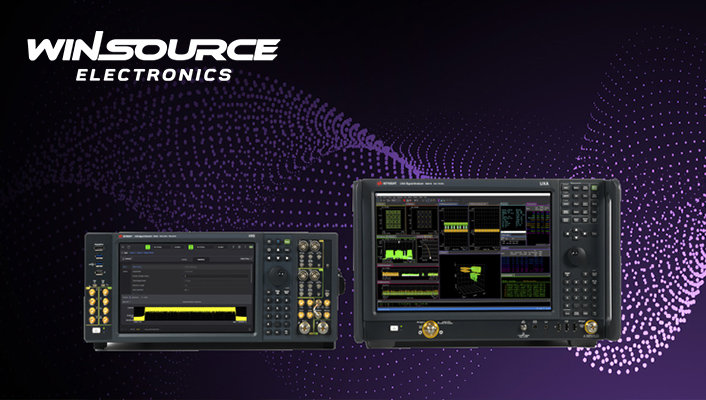
In our interconnected world, where wireless communication, radio signals, and electronic devices permeate our daily lives, the significance of understanding and analyzing electromagnetic frequencies cannot be overstated.
At the heart of this endeavor lies a powerful tool known as the spectrum analyzer. As WIN SOURCE is an industry expert components supplier, we can provide a helpful guide on spectrum analyzers.
So, in this comprehensive guide, we delve deep into the world of spectrum analyzers, uncovering their uses, functionalities, types, and key considerations.
Table of Contents
ToggleUnderstanding the Basics: What is a Spectrum Analyzer?
A spectrum analyzer is an essential instrument used in electronics, telecommunications, and engineering to visualize and analyze the frequency components of a signal.
It takes a complex waveform and breaks it down into its constituent frequencies, allowing engineers and technicians to observe the amplitude and frequency characteristics of a signal.
This capability makes spectrum analyzers invaluable in various industries, including telecommunications, radio astronomy, audio engineering, and RF (Radio Frequency) testing.
So what are the principles behind how a spectrum analyzer works? Let’s look at that next.
If you have a need for spectrum analyzers, then there is a good chance you are working with electronic components.
For assistance in sourcing and supply chain management of your component needs, contact us today so we can help. We deal with a host of popular component manufacturers, providing a one-stop shop for your electronic component needs.
Working Principles: How Spectrum Analyzers Operate
Spectrum analyzers operate on the principle of signal processing and Fourier analysis. Here’s a simplified breakdown of their operation:
● Signal Input: The instrument takes an analog or digital signal as input. This signal could be a radio frequency, audio, or any other waveform.
● Signal Conditioning: The input signal is amplified and filtered to ensure accurate analysis and prevent overload.
● Frequency Conversion: The signal is converted from the time domain to the frequency domain using a process called Fast Fourier Transform (FFT).
● Display: The frequency components are displayed on a graph, typically with frequency on the x-axis and amplitude on the y-axis.
● Resolution Bandwidth and Sweeping: Spectrum analyzers allow users to control the resolution bandwidth, which affects the level of detail in the frequency analysis. The instrument can also sweep through a range of frequencies, producing a visual representation of signal strengths across the frequency spectrum.
Key Features and Functionalities
Modern spectrum analyzers come equipped with an array of features and functionalities that enhance their versatility and utility. Some key features include.
Now let’s explore the types of spectrum analyzers that fit this type of functionality…
Types of Spectrum Analyzers
Spectrum analyzers can be categorized into two main types based on their underlying technology:
Swept-Tuned Spectrum Analyzers
These traditional analyzers sweep through a frequency range, measuring and displaying the power levels of signals at each frequency point. While accurate, they are slower in capturing rapidly changing signals.
Real-Time Spectrum Analyzers
These analyzers capture and process signals in real time, making them ideal for analyzing dynamic and intermittent signals. They are well-suited for applications like wireless communication and radar analysis.
Applications and Industries
The versatility of spectrum analyzers lends them to a wide range of applications across various industries:
● Telecommunications: Spectrum analyzers are used for testing and optimizing wireless communication systems, identifying interference sources, and ensuring compliance with frequency regulations.
● Audio Engineering: In this field, spectrum analyzers aid in analyzing audio signals, optimizing sound systems, and identifying unwanted noise or distortion.
● RF Testing: In research and development, spectrum analyzers help engineers analyze and design RF circuits, antennas, and components.
● Radio Astronomy: Astronomers use specialized spectrum analyzers to study celestial objects by observing their electromagnetic emissions across the radio frequency spectrum.
● EMC (Electromagnetic Compatibility) Testing: Spectrum analyzers play a vital role in identifying and resolving electromagnetic interference issues in electronic devices.
● Wireless Network Maintenance: Analyzing Wi-Fi signals, cellular networks, and other wireless communication systems helps technicians optimize network performance.
Choosing the Right Spectrum Analyzer
Selecting the appropriate spectrum analyzer for your needs involves considering various factors:
● Frequency Range: Ensure the analyzer covers the frequency range relevant to your application.
● Resolution Bandwidth: Choose a resolution bandwidth that suits your analysis requirements.
● Dynamic Range and Sensitivity: Consider the level of sensitivity and dynamic range needed for accurate measurements.
● Real-Time vs. Swept-Tuned: Determine whether real-time analysis is essential for your application or if a traditional swept-tuned analyzer suffices.
● Portability and Form Factor: Depending on your usage scenario, consider the size and portability of the instrument.
● Budget: Spectrum analyzers come in a wide price range, so align your choice with your budget and required features.
Spectrum Analyzer – Conclusion and Next Steps
In a world where information is transmitted through invisible frequencies, spectrum analyzers serve as the eyes that unveil this hidden realm.
These powerful instruments play a pivotal role across industries, enabling engineers, scientists, and technicians to understand, troubleshoot, and optimize signals in various frequency ranges.
From telecommunications to audio engineering, spectrum analyzers empower us to harness the invisible forces that shape our modern world.
As technology continues to evolve, so too will the capabilities of these invaluable tools, ensuring that we can navigate the complex landscape of electromagnetic frequencies with confidence and precision.
To navigate the often complex world of electronic components for large industries, sourcing both obsolete and current components can be a challenge. This is where WIN SOURCE can help. Contact us today for help in sourcing and supply chain management of your component needs.

COMMENTS